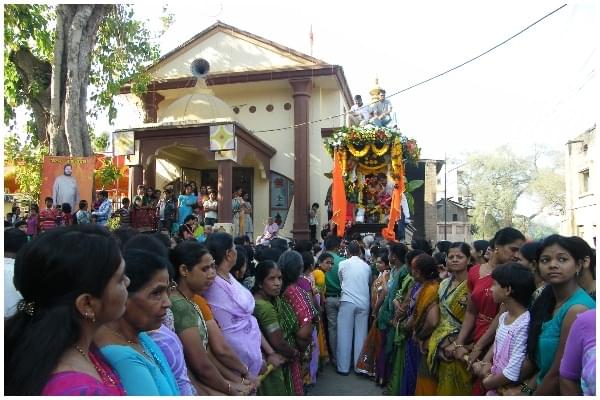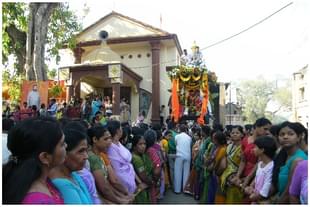Culture
Sangamner: Where Women Of The Town Lead The Hanuman Rath Yatra
Shefali Vaidya
Mar 31, 2018, 02:29 PM | Updated 02:29 PM IST
Save & read from anywhere!
Bookmark stories for easy access on any device or the Swarajya app.


Sangamner is a sleepy little place in Maharashtra, located at a distance of 110 kms from Pune on the confluence of three rivers, the Pravara, Mhalungi, and Mahanuti. At first glance, Sangamner looks like any other small town in Maharashtra, surrounded by lush green sugarcane and billboards advertising saree shops and educational institutions.
What sets Sangamner apart is the unique Hanuman Jayanti celebration of the town. Every year on Hanuman Jayanti, Sangamner town reverberates with the sound of the clear, high voices of hundreds of women shouting ‘Bajrangbali Ki Jai. Pawansut Hanuman Ki Jai’, as the wooden chariot with an Utsav Murti of Shri Hanuman rolls out of the ancient Hanuman temple precincts and passes through the roads of the city with people jostling to get a glimpse of the deity. What makes the Rathyatra of Sangamner special is the fact, that it is the women who have the first right to pull the chariot of Brahmchari Hanuman!
Sangamner has had a long standing custom of celebrating Hanuman Jayanti that dates back to the Maratha rule. However, this unique tradition of women pulling the chariot has its roots in incidents that occurred in in the late 1920s under the British rule. Somewhere around 1925, a new chariot was made by a local carpenter, Namdev Sutar The chariot had wooden figures of Shivaji Maharaj and Mahatma Gandhi flanking the deity on both sides. The local British administration was enraged by this and resented the charged atmosphere among the local people during the celebrations.
In 1927, the then administration banned the Hanuman Rathyatra for five years, citing communal tension as a reason. Hanuman Jayanti fell on 17th April that year. The local residents were enraged at the unjust order of the government and started with the Rathyatra in defiance. However, the local police stopped them soon after and refused to let the people continue with the Rathyatra. There was a lot of commotion and resistance, but the local administration quelled it using brute force. The chariot was forced to be abandoned mid-way and the deity was forcibly returned to the temple.
In 1928 the people of Sangamner tried to defy the ban again and take out the Rathyatra on Hanuman Jayanti, but this time too they were stopped by the police. Enraged people of Sangamner refused to take the chariot back to the temple in protest and the chariot remained where the people had left it for two whole months, before the administration managed to convince some of the residents to take it back to the temple.
In 1929 again, it looked like the same scene was going to be repeated. The local people were getting restive and were in a mood to retaliate. The police was aware of the anger and had slapped section 144 in the village to control the crowds. Extra police force had been called from Nagar to deal with the crowds.
However, weeks before Hanuman Jayanti, some women from the village led by a brave lady called Zumbarbai Aausak had already decided that this years Rathyatra would be completed, come what may. Zumbarbai was an illiterate widow, who lived in a lane called Khandoba Galli with her children. She was a spirited woman though, who ran her own small tailoring outfit. She was aware of the tensions in the town and was seething in rage at the high-handedness of the British administration.
As the police were totally focussed on dealing with the men of Sangamner, Zumbarbai decided that she would pull the chariot of Hanuman along with the women of the village. Weeks leading to Hanuman Jayanti were spent in persuading the women of the village to pull the chariot of Hanuman.
The day of Hanuman Jayanti fell on 23rd April in 1929. The police and the administration had made anticipatory arrests of the prominent citizens of Sangamner on 22nd night. Hanuman Jayanti dawned in an atmosphere of tension and anger.
Police had already cordoned off the area near the Hanuman temple. They did not allow the people to take the Utsav Murti of the deity out of the temple to place it in the chariot. Massive arguments broke up between the citizens and the police. By this time, women had already started gathering near the temple in large numbers. Amidst all the confusion, Zumbarbai climbed up on the chariot carrying a small photograph of Shri Hanuman. She was joined by other women from the village like Bankabai Pardeshi, Leelatai Pingle and some others. Before the police could realise what was happening, the enraged women of the village had started pulling the chariot.
So great was the power of the collective Naari Shakti that the chariot moved rapidly before the police realised what was happening. When they tried to stop the chariot from moving, Zumbarbai and other women threw Gulaal at the eyes of the police personnel and marched ahead, pulling the chariot with great strength. The bullock carts that the police had kept as road-blocks toppled like nine-pins in front of the great surge and fury of the women.
The women of Sangamner managed to successfully complete the Rath Yatra! that year, to the sound of great cheering from the people of Sangamner. Zumbarbai and the other women in the chariot were arrested. But as section 144 was not applicable for women at the time, the trial was considered void and Zumbarbai and her companions were freed.
Since then, it is the women of Sangamner who have the first right to pull the chariot of Hanuman every year on Hanuman Jayanti. Zumbarabai enjoyed the honour of sitting in the chariot as long as she lived. Zumbarbai died in 1983, after a long and eventful life, but the Shaktis of Sangamner continue to pull the chariot of Hanuman every year as a tribute to her strength and spirit.
As an act of penance on behalf of the police, the Hanuman Jayanti celebrations in Sangamner today are kicked off only after a presentation of a saffron flag and an aarati to Shri Hanuman performed on behalf of the local police station!
The women of Sangamner are proud of their unique tradition and consider it a great tribute to the innate strength of the feminine.
The writer is a freelance writer and newspaper columnist based in Pune.





